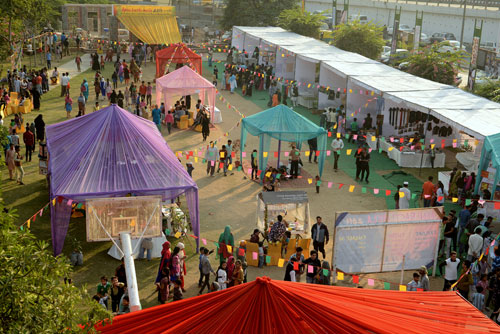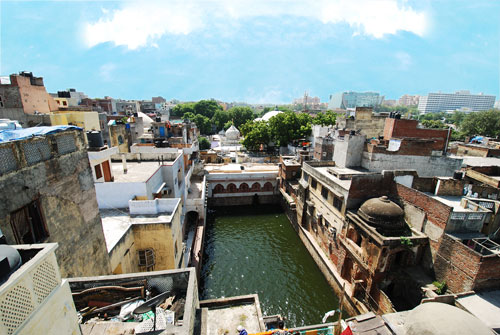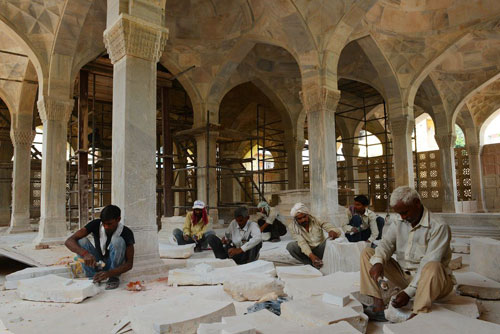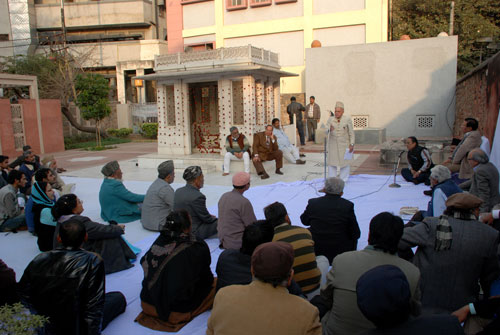|
|
The South
Asian Life & Times - SALT |
|
|||
|
Contents Feature Heritage People
Book Reviews Kaavad
Traditions of Rajasthan
- exploring
|
|
||||
|
Nizamuddin Basti
Nizamuddin Basti, with its living culture,
forty-five listed monuments and a diverse community, is undergoing major
transformation. Apart from various restoration woks, the project is also
improving the living standards within the Basti. The dargah (shrine) of the 14th century Sufi saint
Hazrat Nizamuddin Auliya is the epicentre of Nizamuddin Basti (settlement) –
the densely populated neighbourhood that surrounds the dargah. While the dargah has
existed for seven centuries, the Nizamuddin basti surrounding the dargah has
existed in its present form only for about seventy years. In the intervening
centuries, the area surrounding the dargah was one large graveyard
(primarily because of its closeness to Hazrat Nizamuddin Auliya’s dargah),
with a small settlement of caretakers of the shrine. It was at the time of
Partition in 1947 that the basti began to evolve in its present avatar as a
result of refugees settling in the area.
The basti, in the last
seventy years, has grown into a self-contained urban sprawl – a warren of
tangled narrow alleys, haphazard and unrestricted construction, congested
housing, limited public conveniences -
intermingled
with centuries
old shrines, tombs and a baoli (step well).
The
restoration work by Aga Khan Foundation only started when one of the baoli’s
walls began to collapse. It was rebuilt with the
help of state-of-the-art technology, including Ground Penetrating Radar
Survey, High Definition 3D laser scans and geotechnical assessments, but
using original construction techniques.
Subsequently, seven centuries of
accumulated waste was also removed manually from the baoli.
Nizamuddin Baoli
The Baoli was built by
Hazrat Nizamuddin Auliya in the years 1321-22. It is the only step-well in
Delhi still fed by underwater springs, albeit heavily polluted by sewerage
and garbage. A portion of the baoli wall collapsed in July 2008 endangering
human life and necessitating urgent remedial measures. Following a thorough
assessment, the baoli was partially drained and the collapsed portions
rebuilt as per original construction techniques. This was an opportunity to
manually de-silt the baoli of debris accumulated over hundreds of years.
Water from the baoli was tested and revealed high levels of E-coli from
sewage contamination. Over 100m of sewer lines were laid as part of the
conservation initiative, thereby greatly improving the water quality with
drastic reduction in E coli levels. Waste water from the
wuzu area which earlier drained
into the baoli has since been re-routed. During the restoration work, a blocked passage
connecting the baoli to the mosque was discovered. It is believed to have
been used by Hazrat Nizamuddin and its discovery was the cause of much
celebration. Chaunsath
Khamba (Pavilion of Sixty-four pillars) Near the dargah is the Chaunsath Khamba pavilion -
the tomb of Mirza Aziz Koka, the foster brother of Emperor Akbar
(r.1556-1605). Many others are also buried in and around the dargah,
including Akbar's chronicler Abu'l-Fazl (1551-1602) Shah Jahan's daughter
Jahan Ara (1614-81), and South Asia’s most noted poet – Mirza Ghalib. Constructed wholly of white marble with 64 pillars
inside, it was built by Aziz Koka in his life time in early-17th century and
when he died in 1624 at Ahmedabad, he was brought here and buried. The tomb,
unique in design and adornment, was enclosed within a rubble masonry wall in
the 1960s to protect it from vandalism and encroachment. This wall
segregated the monument from its forecourt, an integral element of the
original design. The wall has since been removed and the adjoining open
spaces unified for cultural uses such as qawwali performances. Excessive water seepage and inappropriate past
repairs, using cement and concrete, had damaged the marble. Layers of
concrete were carefully removed from the roof and the original roof levels
were restored to ensure quick water drainage. Conservation of the tomb will
be combined with improvement in the façade of the surrounding residences.
Landscaping of Mirza Ghalib's Tomb
The 19th
century tomb of Mirza Ghalib, one of the most renowned poets of India during
the Mughal period, stands on a busy street of the basti. The iron fencing
enclosing the tomb was replaced with hand carved sandstone lattice screens,
thus separating the grave from the busy street. The concrete pavement was
replaced with sandstone and white marble inlay – forming a tranquil little
courtyard. Both Mazar-e-Ghalib and its neighbouring Chaunsath Khamba have
come alive as cultural venues since they were restored in 2010. The major accomplishment of the project has been its
endeavour to improve environmental conditions and urban facilities in areas
of education, health and sanitation. Public toilets, parks for women and
children, a gym for women are recent additions to the basti and also a
cricket field on popular demand by the residents. Activities such as
theatre, craft workshops and heritage walks are held regularly. Women have
been taught traditional crafts to supplement the family income with sale of
their products. The Municipal Corporation of Delhi is planning a
major street improvement scheme to further enhance the ambience of
Nizamuddin Basti.
|
|||||
|
Copyright © 2000 - 2015 [the-south-asian.com]. Intellectual Property. All rights reserved. |
|||||



